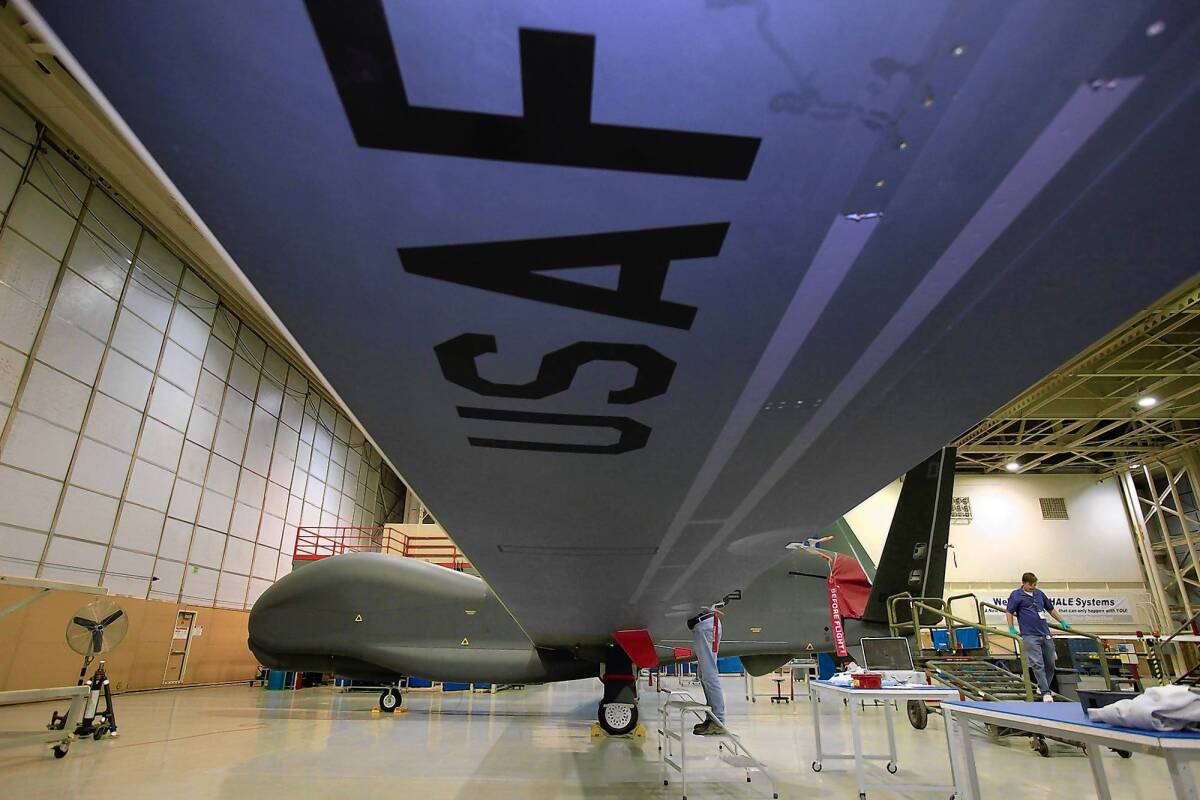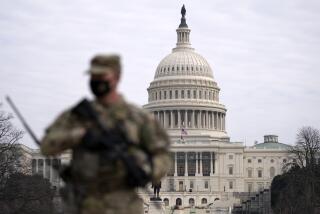Global Hawk drone flies into budget battle between Pentagon, Congress

When the Air Force looked for ways to save money last year to deal with declining budgets, officials decided to halt work on a high-flying, long-endurance spy drone built in Palmdale by defense giant Northrop Grumman Corp.
At a cost of $35,000 per flying hour, the Global Hawk Block 30 aircraft had “priced itself out of the niche, in terms of taking pictures in the air,” Deputy Secretary of Defense Ashton Carter said at the time.
The Air Force planned to stop buying the Global Hawk and mothball 18 of those it already owned to save about $2.5 billion over five years. The high-tech drones, the military said, were not as capable as the battle-tested U-2 spy planes.
Northrop responded sharply, saying the U-2 “places pilots in danger, has limited flight duration and provides limited sensor capacity.”
In the end, the Air Force didn’t win that skirmish. House Armed Services Committee Chairman Howard “Buck” McKeon (R-Santa Clarita), whose congressional district includes Palmdale, jumped in to rescue the project. Congress restored the funding, and last month Northrop received a $114-million contract to build three more drones, saving thousands of jobs.
The Pentagon faces budget cuts of $487 billion over the next 10 years — and the threat of $500 billion more under sequestration. But paring down the budget by killing weapons programs is no easy task on Capitol Hill, where politicians, backed by the defense industry lobby, fight to protect jobs in their home districts.
For instance, Congress has spent about $400 million in the last two years to churn out improved versions of the M1 Abrams tank that the Army doesn’t want. The Navy cruiser Anzio out of Norfolk, Va., was supposed to be retired this year but lawmakers kept it afloat. Just last month, 33 lawmakers wrote Secretary of Defense Chuck Hagel to express “deep concern” about the Air Force’s consideration of cutting the A-10 attack jet fleet.
In the case of the Global Hawk, McKeon said he worked to keep the program alive because the drone is a valuable tool for spying, and he wanted to protect the billions of dollars the government has already spent on the technology.
“I think these planes have proven their capabilities,” McKeon said, “and will continue to show their worth over time.”
Critics say the allocation of funding for the Global Hawk reflects cozy ties between Congress and defense companies. Northrop has been one of McKeon’s largest campaign donors and spent more than $17.5 million on total lobbying last year, according to data from the Center for Responsive Politics, a watchdog group. The defense firm has spent $13.2 million this year.
“The mantra in the defense industry is: Give early and give often,” said Steve Ellis, vice president of Taxpayers for Common Sense. “Clearly, McKeon is in a good position to protect this investment, and it has the added benefit of providing jobs to his constituents back home.”
Northrop has more than 3,480 employees — 2,500 of them in Southern California — working on the Global Hawk program in 22 states. It has contracts with 303 suppliers in 36 states.
The Air Force has been flying the Global Hawk since 2001, including missions in Iraq, Afghanistan and Libya. The drone can fly for 30 hours without refueling.
Even from more than 11 miles overhead, the drone is able to capture images of enemy hide-outs that are so clear that U.S. intelligence officials can determine the make, model and license plates of pickup trucks parked nearby — and tell how long they’ve been there.
Military planners had wanted Global Hawks to replace the fleet of 33 U-2 spy planes, which have been in service since the 1950s. But repeated problems with the drones’ equipment and flight reliability, and their high price tag, caused the Air Force to put the program on hold last year.
The drone costs $222.7 million each, according to the Government Accountability Office.
In addition, mission personnel costs for the Global Hawk “are substantially higher than those of the manned U-2, despite the fact that the number of flight hours for the Global Hawk and the number of aircraft are substantially below those of the U-2,” the Air Force said.
The U-2 costs $4,000 less per flight hour and has more capability, the Air Force said.
Critics of the Pentagon’s plan have said that the Air Force harbors a bias against the Global Hawk because it doesn’t have a pilot in the cockpit. Air Force brass has strongly refuted that criticism.
The Air Force wanted to put all 18 of the third version of Global Hawk, called Block 30, in storage at the bone yard at Davis-Monthan Air Force Base in Arizona. This would leave the Air Force with 14 Global Hawks in operation.
Not long after the Pentagon’s announcement last year that it was going to shut down the Global Hawk program, McKeon made a rousing speech at Northrop’s manufacturing plant in Palmdale. He asked the crowd to call members of Congress to stop the cuts.
“I implore you, no, I beg you, to stop this from happening,” he said at the time. His committee later passed an amendment that would prevent the Air Force from retiring the planes.
In May, McKeon and Rep. James P. Moran (D-Va.), whose district includes where Northrop’s headquarters is based, wrote a letter to Hagel that the Air Force was trying to “ignore clear congressional intent.”
Last month, Northrop announced it had received a $114-million contract for the first phase of a contract to build the last three Block 30 Global Hawks.
“The budget situation is a nightmare,” said Todd Harrison, a defense analyst for the Center for Strategic and Budgetary Assessments in Washington. “It’s well-known that there isn’t enough money. Programs need to be cut, but Congress continues to micromanage the military budget.”
More to Read
Inside the business of entertainment
The Wide Shot brings you news, analysis and insights on everything from streaming wars to production — and what it all means for the future.
You may occasionally receive promotional content from the Los Angeles Times.











